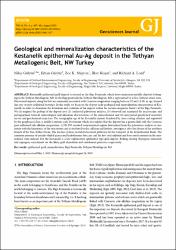Geological and mineralization characteristics of the Kestanelik epithermal Au-Ag deposit in the Tethyan Metallogenic Belt, NW Turkey
Abstract
Kestanelik epithermal gold deposit is situated in the Biga Peninsula, which hosts numerous metallic deposits belonging to the Tethyan Metallogenic Belt. In the Biga peninsula the Tethyan Metallogenic Belt is represented by a Neo-Tethyan suture zone. Discovered deposits along the belt are commonly associated with Cenozoic magmatism ranging between 52 and 18 Ma in age, formed due syn- to post-collisional tectonics. In this study, we focus on the deposit-scale geological and mineralization characteristics of Kestanelik in order to determine the formation and evolution of the deposit within the tectono-magmatic history of the Biga Peninsula. We (1) mapped the geology of the deposit area (2) conducted paleostress analyses, (3) observed and examined the macroscopic and petrographical textural, mineralogical and alteration characteristics of the mineralization and (4) interpreted geophysical resistivity survey and geochemical assay data. The stratigraphic age of the Kestanelik deposit, bracketed by cross cutting relations and supported by the geophysical data, is middle Lutetian-early Priabonian which also implies that the deposit has a genetic link with the Cenozoic post-collisional calc-alkaline magmatism. A NE-SW oriented compressional regime determined from the paleostress analyses is consistent with the kinematics of the vein system and is attributed to the collision and further convergence after the closure of the northern branch of the Neo-Tethys Ocean. The fracture system provided structural pathways for the transport of the hydrothermal fluids. The common presence of pseudo-bladed quartz and hydrothermal breccias, and the low total sulphide and base metal contents in the mineralized veins indicate that the Kestanelik is a low sulphidation epithermal-type gold deposit. Boiling, mixing (hypogene oxidation) and supergene enrichment are the likely gold deposition and enrichment processes respectively.


















